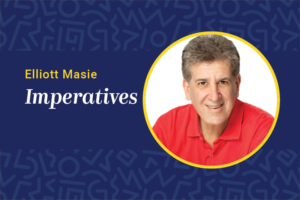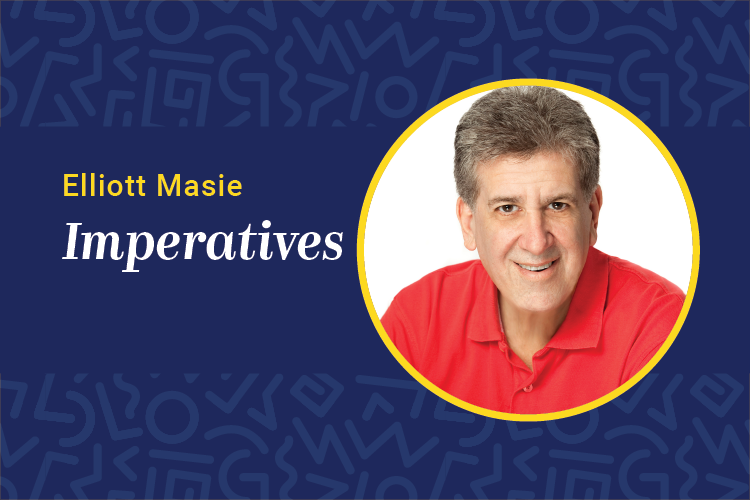 There are many changes afoot in May 2021 as vaccinations expand and businesses enter a phase of restarting or reboarding. There is much to be excited about as people shift their behaviors while medical and governmental rules rapidly evolve. I was recently able to see my mother-in-law in person for the first time in 13 months, as she has been isolated in a nursing home.
There are many changes afoot in May 2021 as vaccinations expand and businesses enter a phase of restarting or reboarding. There is much to be excited about as people shift their behaviors while medical and governmental rules rapidly evolve. I was recently able to see my mother-in-law in person for the first time in 13 months, as she has been isolated in a nursing home.
In conversations with CEOs and chief learning officers, it is clear that businesses are gearing up to enter the next stage of the pandemic era, bringing some workers back to the office and shifting their activities radically. Several airlines in our Learning COLLABORATIVE are rapidly expanding their flight schedules and doing massive retraining for employees who have been furloughed for a year.
But there is a darker side to workforce wellness in spring of 2021. We have been tracking several shifts and crises that learning and talent leaders are currently facing:
Workforce malaise. Bluntly, many of your employees are burned out or exhausted after the challenges of the pandemic. They may be grateful that their employment continued during these tough times, but there are many colleagues who are finding it more and more difficult to be excited, engaged and “forward-looking” this spring.
Take a vacation, please. Talent directors are monitoring a radical reduction in vacation days used by staff. Since most could not travel, why take time off while working from home? There is even a significant reduction in sick leave days, as team members figure they can work while ill from home.
“Groundhog Day” syndrome. Some employees report a “Groundhog Day” effect, reflecting the movie where every day is a repeat of the one before. Workers who are feeling pandemic malaise struggle to get excited and engaged about the next project because time feels circular.
Departures and retirements. Prepare for some sudden departures and retirements. One CEO shared that a senior manager recently announced their instant departure. Many employees have stayed in their current roles longer than expected because of the pandemic, so recruiters are back in action, building up talent pipelines that include some of your best staff. Watch for some fairly sudden goodbyes.
Coaching, please: Organizations are ramping up scalable coaching for a much wider spectrum of the workforce. A friend of mine who leads a major manufacturing company is radically expanding coaching — from both peers and external resources — to provide support and growth for his employees. The coaching of tomorrow may look more like telehealth or colleague-to-colleague support processes, often following the models developed by Master Class instructor and executive coach Marshall Goldsmith and former Ford CEO and president Alan Mulally.
Please don’t freak out about what I’m saying in this column! It’s no surprise that many of our employees are stressed out or “toasted” after coming through a remarkable timeframe. And the pandemic is not over yet. There will be months — or perhaps another year — ahead where organizations and employees will need to experiment with work locations, in-person meetings, conferences, and their own personal or professional futures.
What we do need to concentrate on is the mental health dimension of our workforce in these changing times! Here are some approaches that learning and talent leaders can leverage and explore:
- Mental health of the workforce. We must add this as a perspective to our talent readiness equation and normalize talking about these issues. Ask the CEO and other organizational leaders to reflect on their own current challenges and approaches.
- Change is good and healthy. I have a colleague who is about to announce her departure from an organization where she has worked for 21 years. If it’s time for one of your employees to go, make it OK and healthy for them to do so. Even explore options that could include a leave of absence or a way for them to come back later as an employee or contractor.
- Empathy is everything. Empathy is not sympathy! It is recognizing the reality of our employees’ experiences. Listen and respect the changes that are afoot.
- Prepare for waves of experimentation. Plans may exist for bringing everyone back to the office, or to keep the workforce remote and virtual. These may change! We should experiment with the nature of the workplace and workforce going forward.
- Learning is a powerful tool and force. Ramp up the range of learning resources and options for your employees. A burned-out employee may perk up once they embrace new skills and can imagine future roles. The process of learning can often be one of the best environments for reflection, empathy and re-balance.
Finally, keep the door open to talk about mental health in the workforce. This is real, and our willingness to be connected to our colleagues on these topics is critically important.















